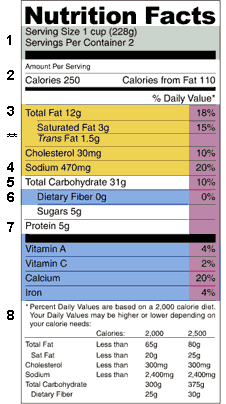Food Labels
Labels on food do give us the most up-to-date nutrient information available. This is how we often find much to our chagrin, that our very favorite comfort food is full of undesirable stuff. Food labels can make us painfully aware of the changes we need to make to get a healthy balance into our eating routine. Reading and understanding the food label is often difficult so how to approach information on the food label is explained below and an example of a food label is shown. Later in this Nutrition Tidbit article, a healthy eating perspective is offered.
Important Food Label Information

- Recommended serving size/Calories per serving. Serving size tells how much food makes up a single serving. (Unfortunately the amount we consider a serving is usually larger!) All data on the label is based on the serving size stated. Because we all need calories, this number can help us figure out how many calories we are getting.
- Calories from fat. If this number equals more than 1/3 of the total calories, the food you are eating is high in fat. Higher fat foods should be eaten in smaller portions.
- Total fat. This equals the number of grams of fat per serving of the food.
** Trans fat. This new item was officially included on the food label in 2006. Trans fat information will usually be found under number 3. If the amount of trans fat per serving is less than or eaual to 0.5 grams, it is legal to present the total amount as zero. - Sodium/salt. The latest recommendation for sodium is less than 2,400 mg of sodium per day, or about a teaspoon of table salt.
- Total carbohydrates. These include sugar, starch, and fiber.
- Fiber. Fiber is an indigestible carbohydrate and aids in elimination. At least 15 grams of fiber per day is recommended.
- Protein. Many foods contain some protein but meat, fish, poultry and dairy foods are highest. Protein needs average between 50-100 grams per day.
- Percent Daily Values. This section gives some estimated nutrients per 2000 and 2500 calories.
So let's use saturated fat as an example of how to put this into perspective.
- First of all, the most recent Institute of Medicine (IOM) guidelines suggest that saturated fat needs to be limited to no more than 7% of total calories. If you are a typical person who needs about 2000 kilocalories per day, your saturated fat intake should be no more than 15 grams per day. In case you did not know, there is some saturated fat in the mix of all fats we have available to eat. Even fish contains a small amount of saturated fat!
- The largest dietary contributors of saturated fat are protein-laden foods – dairy products (cheese, whole and 2% milk, ice cream and yogurt), red meat, fried foods and chocolate.
- Be judicious about everyday choices. When you do not have a particular taste for food, make the healthiest choice – plant protein (legumes, soy and veggies), fish, lean poultry, low fat dairy, etc. These foods are very low in saturated fat so they hardly dent the allowance you get for the day. By being judicious, you’ve built up some reserve. Read number 1 again.
- When you get a hankering for a food high in saturated fat, instead of feeling guilty immediately, go over the facts – if you limit high saturated fat foods most of the time, you can occasionally eat a food with a higher level of saturated fat without guilt because your average intake is low and eating this food does not put you into the “ozone layer” of saturated fat.
So how does one put this saturated fat information into perspective on a festive occasion? A festive occasion, whatever it is – Thanksgiving, Christmas, 4th of July, or a birthday – has foods that call to all of us and will not go away! Regardless of a food’s negatives – saturated fat, high calories, fat, trans-fat, sodium, carbs or whatever a given “healthy living through food” plan says should be avoided – we sometimes want what we know we would be better off avoiding. What do we do?
In the long and short of life, most of us would be well served if we allowed ourselves to eat forbidden foods when we are really craving them. Why? If we do not allow ourselves to eat those foods we usually do one of the following:
- We eat too much food, trying to get that “taste” (and too much of most anything is not good)
- We think something like this: “I want cheesecake. I really shouldn’t eat it. There are 9 grams of saturated fat in 1 piece of cheesecake! But I want the piece of cheesecake. No really, I shouldn’t eat it, it is not good for my heart. Well just this once…” Pretty soon you are eating the cheesecake, feeling really guilty, the guilt increases stress, the stress increases hunger, and before you know it – 2 pieces of cheesecake are down the hatch!
Instead of the above approaches, you might want to try and rethink the whole issue, get into the shades of gray rather than black or white of nutrition, and be realistic. Some folks do better avoiding all foods that have any reputation of being unhealthy lest they go overboard after one bite. However, if you are willing to take the responsibility of limiting “iffy” foods most of the time, then you can occasionally eat and enjoy those foods without guilt or ill health, when they will really “hit the spot.”